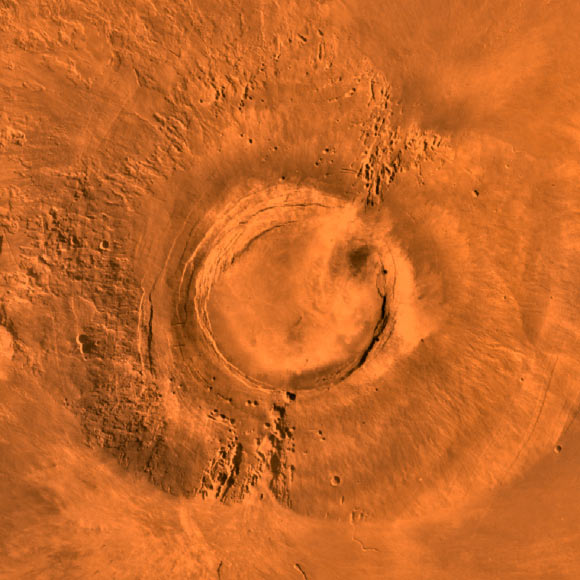According to new research reported in the journal Earth and Planetary Science Letters, the 10-mile- (16 km) high Martian shield volcano called Arsia Mons produced one new lava flow at its summit every 1 to 3 million years during the final peak of activity; the last volcanic activity there ceased about 50 million years ago — around the time of Earth’s Cretaceous-Paleogene extinction.

This digital-image mosaic of Mars’ Tharsis plateau shows the extinct volcano Arsia Mons. It was assembled from images that NASA’s Viking 1 orbiter took during its 1976-1980 working life at Mars. Image credit: NASA / JPL / USGS.
Arsia Mons is part of an aligned trio known as the Tharsis Montes — the others are Pavonis Mons and Ascraeus Mons. It is rivaled only by Olympus Mons in terms of its volume.
This shield volcano was built up over billions of years, though the details of its lifecycle are still being worked out.
The most recent volcanic activity is thought to have taken place in the caldera where 29 volcanic vents have been identified.
Until now, it’s been difficult to make a precise estimate of when this volcanic field was active.
“We estimate that the peak activity for the volcanic field at the summit of Arsia Mons probably occurred approximately 150 million years ago (Jurassic period on Earth), and then died out around the same time as dinosaurs,” said lead author Dr. Jacob Richardson, from NASA’s Goddard Space Flight Center.
“It’s possible, though, that the last volcanic vent or two might have been active in the past 50 million years, which is very recent in geological terms.”
Measuring about 68 miles (110 km) across, the caldera is deep enough to hold the entire volume of water in Lake Huron.
Examining the volcanic features within the caldera required high-resolution imaging, which Dr. Richardson and co-authors obtained from NASA’s Mars Reconnaissance Orbiter.
The authors mapped the boundaries of the lava flows from each of the 29 volcanic vents and determined the stratigraphy of the flows. They also performed a technique called crater counting — tallying up the number of craters at least 330 feet (100 m) in diameter — to estimate the ages of the flows.
Using a novel computer model, the two types of information were combined to determine the volcanic equivalent of a batting lineup for Arsia Mons’ 29 vents.
“Each vent within this caldera produced lava flows several to tens of miles in length; these vents are likely among the youngest on Mars, since no impact craters in their lava flows are larger than 3,280 feet (1 km) in diameter,” the researchers explained.
“First, we modeled the age of each vent with impact crater counts performed on their corresponding lava flows and found very large age uncertainties for the ages of individual vents, often spanning the estimated age for the entire volcanic field.”
“The age model derived from impact crater counts alone is broad and unimodal, with estimated peak activity in the field around 130 million years ago. Next we applied our volcano event age model, which uses a directed graph of stratigraphic relationships and random sampling of the impact crater age determinations to create alternative age models.”
The scientists estimate that the oldest flows date back about 200 million years.
The youngest flows probably occurred 10 to 90 million years ago — most likely around 50 million years ago.
The modeling also yielded estimates of the volume flux for each lava flow. At their peak about 150 million years ago, the vents in the Arsia Mons’ caldera probably collectively produced about 1 to 8 cubic km of magma every million years, slowly adding to the volcano’s size.
“Think of it like a slow, leaky faucet of magma. Arsia Mons was creating about one volcanic vent every 1 to 3 million years at the peak, compared to one every 10,000 years or so in similar regions on Earth,” Dr. Richardson said.
A better understanding of when volcanic activity on Mars took place is important because it helps researchers understand the Red Planet’s history and interior structure.
_____
Jacob A. Richardson et al. 2017. Recurrence rate and magma effusion rate for the latest volcanism on Arsia Mons, Mars. Earth and Planetary Science Letters 458: 170-178; doi: 10.1016/j.epsl.2016.10.040
This article is based on a press-release from the National Aeronautics and Space Administration.







